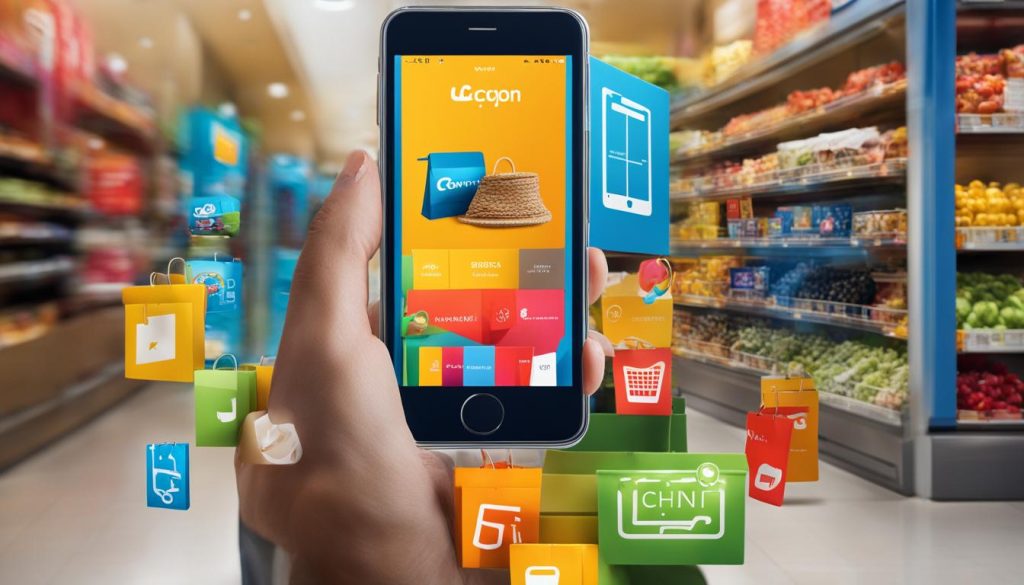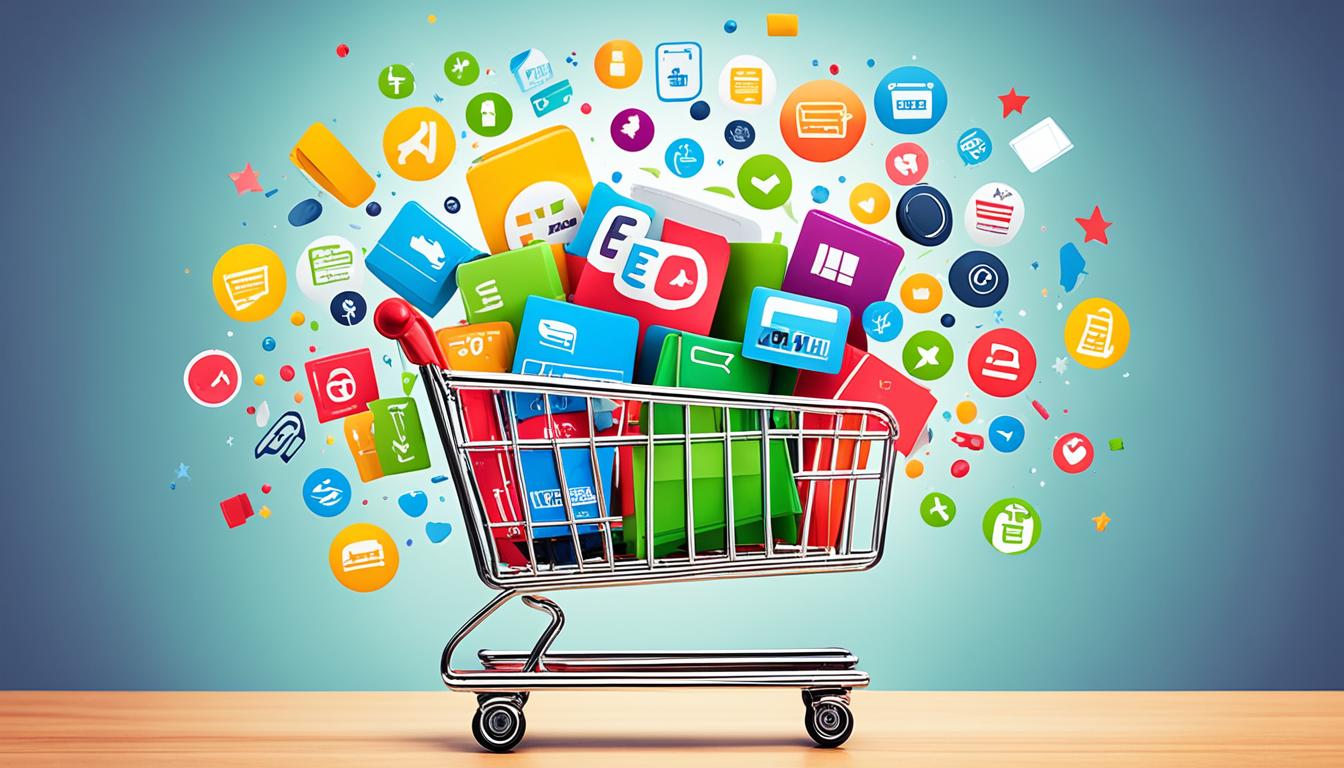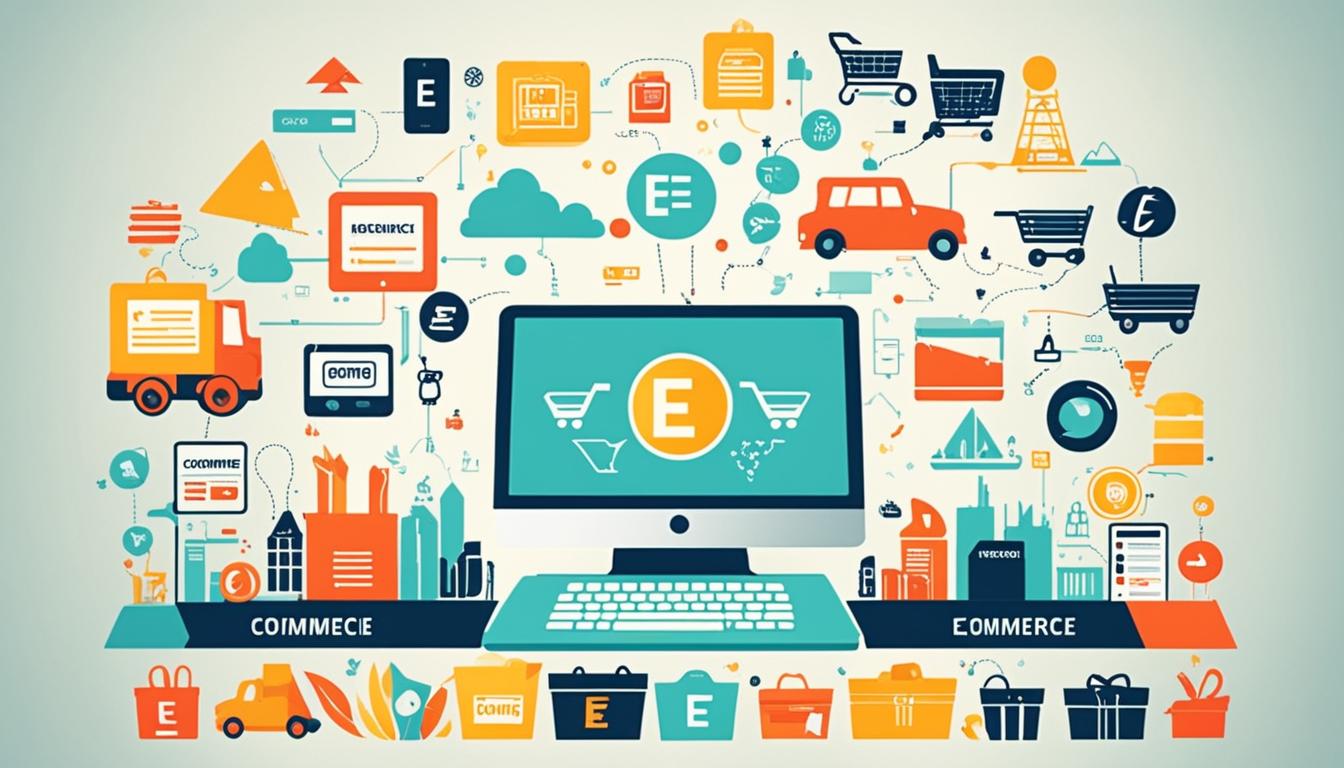E-commerce types
Did you know that by 2025, e-commerce sales are predicted to make up nearly 22% of total purchases in the United States alone? That’s right, the world of e-commerce is booming, and it’s revolutionizing the way we shop and do business.
With this massive growth, it’s essential for entrepreneurs to understand the different types of e-commerce business models available. By choosing the right model for their online venture, they can maximize their chances of success.
Key Takeaways:
- E-commerce sales are projected to make up almost 22% of total purchases in the United States by 2025.
- Understanding the various e-commerce types is crucial for entrepreneurs starting an online business.
- There are multiple e-commerce models to choose from, including B2B, B2C, C2C, M-commerce, Omni-channel, dropshipping, white-label, and subscription e-commerce.
- Each e-commerce model has its unique characteristics, advantages, and challenges.
- By selecting the right e-commerce type, entrepreneurs can tailor their business strategies to meet their target market and maximize profitability.
B2C E-commerce
B2C or Business-to-consumer e-commerce is the most common type of e-commerce. It refers to businesses that sell directly to end-users, the consumers. B2C transactions typically involve shorter decision-making processes and lower-value items. Examples of B2C businesses include online retailers like Amazon and Walmart. B2C innovators have used technology like mobile apps and remarketing to market directly to their customers and provide a personalized shopping experience.
With B2C e-commerce, businesses have the opportunity to connect with consumers on a global scale. The convenience of online shopping has made it easier for consumers to find and purchase products from the comfort of their own homes. This has led to a significant growth in B2C e-commerce over the past decade.
One of the key advantages of B2C e-commerce is the ability to target specific consumer segments and tailor marketing strategies accordingly. By analyzing consumer data and preferences, businesses can create personalized shopping experiences and deliver targeted promotions. This not only increases customer satisfaction but also enhances brand loyalty.
The rise of mobile commerce has further fueled the growth of B2C e-commerce. With the increasing use of smartphones and tablets, consumers can now shop anytime and anywhere. Mobile apps and responsive websites have optimized the online shopping experience, offering convenience and accessibility to consumers on the go.
In summary, B2C e-commerce plays a vital role in the modern business landscape. By directly reaching and engaging with consumers, B2C businesses can drive sales, build brand loyalty, and provide personalized shopping experiences. As technology continues to advance, it is important for businesses to adapt and leverage B2C e-commerce strategies to stay relevant and meet the evolving needs of consumers.
B2B E-commerce
In today’s digital landscape, B2B e-commerce has become a critical component of business growth and success. B2B, which stands for Business-to-business, refers to transactions between businesses, where one company sells its products or services to another company. This model plays a crucial role in industries such as manufacturing and wholesale, where businesses rely on each other for the procurement and distribution of goods.
Unlike B2C (Business-to-consumer) transactions, B2B transactions typically have longer sales cycles and involve higher order values. Businesses must establish trust, build relationships, and provide high-quality products or services that meet the needs of other businesses. B2B e-commerce platforms create an efficient and streamlined process for companies to engage in these transactions, facilitating secure online payments, seamless order processing, and improved inventory management.
In recent years, the rise of younger generations entering the business world has enhanced the importance of B2B selling in the online space. With advancements in technology and the increasing demand for convenience, businesses are finding it necessary to adapt to digital platforms and optimize their B2B e-commerce strategies to stay competitive. Online platforms provide a convenient way for businesses to showcase their offerings, reach a wider audience, and establish themselves as trusted suppliers.
As companies embrace B2B e-commerce, it is crucial to understand the unique dynamics of this model. Developing personalized experiences, providing excellent customer support, and implementing efficient order fulfillment processes are key to success. By leveraging the power of B2B e-commerce, businesses can enhance their reach, streamline operations, and foster mutually beneficial relationships with other companies in their industry.
The Benefits of B2B E-commerce
Implementing a B2B e-commerce strategy can yield numerous benefits for businesses:
- Expanded Market Reach: B2B e-commerce allows companies to access a broader customer base beyond their local market, expanding their reach to national and international markets.
- Improved Efficiency: By automating processes such as order management, invoicing, and inventory tracking, B2B e-commerce streamlines operations, reduces errors, and enhances overall efficiency.
- Increased Sales Opportunities: Online platforms provide businesses with the opportunity to showcase their products or services 24/7, allowing potential customers to make purchases at any time.
- Enhanced Customer Experience: B2B e-commerce platforms enable businesses to provide personalized experiences, tailored pricing, and customized catalogs, enhancing customer satisfaction and loyalty.
- Cost Savings: Digital platforms eliminate the need for costly manual processes, reducing operational expenses and enabling businesses to offer competitive pricing.
| Business-to-Business (B2B) | Business-to-Consumer (B2C) | |
|---|---|---|
| Target Audience | Other businesses | End consumers |
| Order Values | Higher | Lower |
| Sales Cycles | Longer | Shorter |
| Relationships | Building trust and long-term partnerships is crucial | Focuses on individual transactions |
| Personalization | Customized pricing and offerings tailored to each business | May include personalized recommendations and offers |
C2C E-commerce
C2C or Consumer-to-consumer e-commerce is a thriving sector that facilitates transactions between individual consumers. Online marketplaces like eBay and Craigslist have revolutionized the way people buy and sell goods and services directly to each other. This peer-to-peer model offers convenience and accessibility to both buyers and sellers, creating a vibrant ecosystem of consumer-driven commerce.
In C2C e-commerce, individuals can list their products or services for sale, while potential buyers can browse and make purchases. This direct interaction eliminates the need for intermediaries, resulting in cost savings and greater control over the transaction process. However, C2C businesses often charge transaction or listing fees to facilitate platform maintenance and support.
While C2C e-commerce provides opportunities for self-propelled growth and income generation, it also presents unique challenges. Ensuring quality control in transactions can be a concern, as it relies on the integrity and reliability of individual sellers. Additionally, maintaining the technology infrastructure to support a large user base and handle secure transactions requires continuous investment and innovation.
Despite these challenges, the popularity of C2C e-commerce continues to rise, driven by its convenience, competitive pricing, and diverse product offerings. The ability to connect with fellow consumers and engage in peer-to-peer transactions has empowered individuals to turn their hobbies, unused items, or professional skills into profitable ventures.

| Advantages | Disadvantages |
|---|---|
| Opportunities for individuals to monetize their possessions or skills | Potential lack of quality control |
| Wide range of product offerings | Reliance on individual sellers’ integrity and reliability |
| Lower costs due to the absence of intermediaries | Transaction or listing fees |
| Direct interaction between buyers and sellers | Technology maintenance and scalability challenges |
M-commerce and Omni-channel E-commerce
As the use of mobile devices such as smartphones and tablets continues to rise, businesses have recognized the immense potential of M-commerce, or mobile commerce. With M-commerce, customers can conveniently make e-commerce transactions anytime and anywhere, right from the palm of their hands. This shift towards mobile shopping has prompted businesses to optimize their websites and develop mobile apps to cater to the growing number of mobile-savvy consumers.
On the other hand, Omni-channel e-commerce focuses on providing a seamless shopping experience across multiple channels. This approach ensures that customers have a consistent experience regardless of the channel they choose, whether it’s online, mobile, or even within brick-and-mortar stores. By integrating various channels and technologies, businesses can offer customers the flexibility to engage with their brand in a way that suits their preferences.

By embracing M-commerce and Omni-channel e-commerce strategies, businesses can enhance their reach and engage with customers on multiple touchpoints. This not only increases customer satisfaction but also drives sales and fosters brand loyalty. As technology continues to advance, it’s crucial for businesses to adapt and leverage these innovative approaches to stay competitive in the evolving world of e-commerce.
Dropshipping and White-label E-commerce
When it comes to e-commerce models, two popular options for entrepreneurs are dropshipping and white-label e-commerce. These models offer unique advantages in terms of inventory management and branding. Let’s take a closer look at each one:
Dropshipping
Dropshipping is a hassle-free e-commerce model where the seller doesn’t need to hold any inventory. Instead, the seller promotes and sells products that are fulfilled and shipped by a third-party supplier or manufacturer. This means that the seller doesn’t have to worry about the costs and logistics of storing and shipping products.
Dropshipping offers several benefits for aspiring online retailers. Firstly, it allows for a wide range of products to be offered without the need for upfront investment or a physical storefront. The seller can choose from a vast catalogue of products and market them to potential customers. This flexibility allows entrepreneurs to explore various niche markets and capitalize on trending products.
Secondly, dropshipping reduces the risk of unsold inventory. With traditional e-commerce models, a seller might invest in bulk inventory and risk being unable to sell all the products. Dropshipping eliminates this risk since products are only purchased from the supplier when a customer places an order. This pay-as-you-go approach minimizes financial risks for the seller.
| Advantages of Dropshipping | Disadvantages of Dropshipping |
|---|---|
|
|
White-label E-commerce
White-label e-commerce provides an opportunity for entrepreneurs to create their own brand and boost brand visibility without manufacturing their own products. In this model, the entrepreneur partners with a third-party distributor or manufacturer who supplies products or services that can be rebranded and sold under the entrepreneur’s own brand name.
By leveraging white-label products, sellers can focus on marketing, branding, and customer experience, while leaving the manufacturing and supply chain management to the distributor. This allows for faster time-to-market and cost savings compared to manufacturing products from scratch.
White-label e-commerce also offers the advantage of brand customization. The entrepreneur has the freedom to tailor the white-label products to their target market and differentiate their brand from competitors. This customization can range from branding and packaging to adding unique features to the products.
| Advantages of White-label E-commerce | Disadvantages of White-label E-commerce |
|---|---|
|
|
Both dropshipping and white-label e-commerce offer unique advantages for entrepreneurs looking to enter the e-commerce space. Dropshipping eliminates the need for inventory management and allows for a wide range of products to be offered, while white-label e-commerce provides the opportunity to build a brand without manufacturing products. Whether you choose to go the dropshipping route or opt for white-label products, carefully consider your business goals and customer needs to make an informed decision.
Subscription E-commerce
The popularity of subscription e-commerce has grown significantly across diverse industries. This innovative model revolves around selling products or services on a recurring basis, often requiring a subscription fee. At the heart of this approach is the convenience and savings it offers to customers, while businesses benefit from consistent and predictable revenue streams.
Subscription services can be found in various sectors, including beauty, food, and entertainment. Customers appreciate the personalized experience and the convenience of having products delivered right to their doorstep without the need to constantly repurchase. From curated beauty boxes to meal kits and streaming services, the subscription e-commerce market has evolved beyond traditional offerings like magazines, catering to a wide range of customer needs and preferences.
With subscription e-commerce, businesses can build long-term relationships with their customers, fostering loyalty and repeat purchases. By leveraging data and insights from subscribers, companies can better understand their customers’ preferences and tailor their offerings accordingly. This customer-centric approach allows businesses to stay ahead of the competition and provide a truly personalized shopping experience.
In the Canadian market, subscription e-commerce has seen substantial growth, with businesses like Chefs Plate, FabFitFun, and Crave dominating their respective industries. As more consumers turn to online shopping, the convenience and cost-effectiveness of subscription services make them an attractive option. Whether it’s discovering new products or enjoying curated experiences, subscription e-commerce continues to reshape the way we shop and interact with brands.
FAQ
What are the different types of e-commerce business models?
What is B2C e-commerce?
What is B2B e-commerce?
What is C2C e-commerce?
What is M-commerce and Omni-channel E-commerce?
What is dropshipping and white-label e-commerce?
What is subscription e-commerce?
- How Strategic SEO Drove Growth for a CPAP E-commerce Brand - July 24, 2025
- Top 3 SEO Companies in Toronto: An Analytical Comparison - July 23, 2025
- SEO for Entry Door Services - April 24, 2025





















Post Comment
You must be logged in to post a comment.